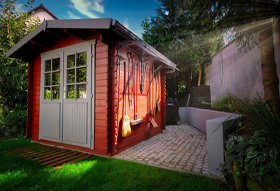Shed and Cabin Foam

As many of us continue to work from home, those with a lack of indoor space have converted their outdoor sheds and cabins into appropriate working and relaxing environments. What is appealing about converting a typical garden shed is that most sheds and certain types of cabins are also exempt from planning permission. Therefore, they can be a relatively straightforward solution for those requiring extra space.
If you pay for your shed or outhouse cabin monthly (i.e. you have purchased it via finance), you will need to check your purchase's terms and conditions before making any significant changes to it. Likewise, before starting, it is also important to assess whether your shed or cabin is suitable for insulation, as those made from either plastic or metal typically do not work well with insulation.
To properly heat insulate a shed, the walls, floor, doors, and windows will need to be accounted for. Depending on your budget and your shed's intended use (such as whether it would house electronic items like a computer), different levels of insulation will be required. Likewise, most basic sheds do not come with weatherproof doors. Some mid-higher end cabins and outhouses do, but it is worth checking with your manufacturer.
To begin with appropriate insulation, you must ensure that any gaps within the construct are sealed with a suitable material such as a waterproof filler. If the inside of your shed or cabin has walls that are already finished (more common in purpose-built outdoor cabins), foam sheets can be used to insulate.

We recommend selecting a high-density polyethylene foam for insulating the walls of your shed or cabin. Our recommendation in most cases is Zotefoam Plastazote Superior closed-cell foam as this can be used for both floors and walls. It is also incredibly durable and is resistant to impact, alongside being waterproof and an excellent thermal insulator. It can also be easily shaped to meet specific dimensions or uniquely shaped areas within your space that need insulating. However, please note that this particular grade of foam is not fire retardant.
Foam can be ordered using our online cut to size foam tool, enabling you to specify every required dimension. When installing foam insulation, these should be placed horizontally and set against the frame of the wall. We recommend using industrial glue to fix the foam sheets to the wall studs before using a heavy-duty staple gun or long nails for reinforcement.
When placing your foam sheets, these should continuously overlap and not sit side by side to ensure maximum insulation quality. For the ceiling, there should be a two-inch gap between the foam and ceiling wall to ensure moisture to escape. The overlaps should continue to move up the wall horizontally, and once complete, the foam sheets should be covered with drywall to improve appearance. You may also consider installing extremely high-density floor insulation and topping it with a breathable membrane, which can reduce 40% of heat lost through a shed floor. Reconstituted super firm chipped foam can also be used for the floors.
For guidance on any foam insulation, please contact one of our friendly advisers at Easyfoam today.
